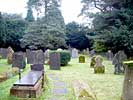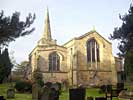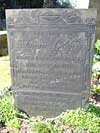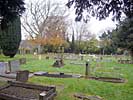For this church:    |
Wollaton St LeonardChurchyard
St Leonard's Church is located in a churchyard of about 2,500 square yards (2,090 square metres) of which the building itself occupies about 20%. The ground has probably been used for burials for at least eight centuries. The area is roughly square and bounded on the west by a stone wall, which is listed, on the north by a brick wall and on the east and south sides by dwarf walls and fencing, all largely obscured by undergrowth. The north-east corner abuts on to the Old Rectory. Immediately south west of the tower there was formerly a gateway which provided direct access to the south porch, but this was blocked up in 1970 for reasons of road safety. It seems likely that none of the existing area has ever been built on except for the small enclave in the angle of the chancel and the north aisle. This was occupied by the short-lived octagonal vestry between 1946-70.
Although some parts have been cleared of graves and there is a dedicated area for the interment of ashes, the overall impression is one of a well tended graveyard with a good selection of memorials, mostly from the 18th and 19th centuries. About 120 gravestones survive and their inscriptions have been transcribed: see www.stleonardswollaton.org.uk. Such markers would have been rare before the 17th century and some after that date would have been made from wood rather than stone. The most notable gravestones are those made of slate, no doubt from the Swithland quarries, though later ones are likely to be Welsh. The slate headstone mentioned specifically by Pevsner to Richard Attenborough or Attonbrow, 1728 cannot currently be identified. The area to the north of the church is devoid of gravestones. This is due partly to the clearance made in connection with the new vestry in 1970, but partly to the medieval reluctance for superstitious reasons to bury on the ‘devil’s side’ of the church.
Clearly burials over some eight centuries greatly exceed the number of memorials. The burial registers between 1576 and 1879 record possibly 2,000 interments and there might be a comparable number from the three or four preceding centuries. This total suggests that plots have been used over and over again, which might partly account for the height of the graveyard above the adjacent highway and the west end of the church. By 1879 the churchyard was deemed to be full and it was formally closed and superseded by a new cemetery in what is now Bramcote Lane on a plot of land given by Lord Middleton. The Revd Henry Russell is commemorated by a handsome headstone. There are similar ones to other members of his family.
This became full within a century and was closed in 1987. Occasional interments of both coffins and ashes continue to take place where space has been reserved for them. The cemetery was provided with a mortuary chapel designed by G.T. Hine (1842-1916), who was the son of the eminent local architect, T.C. Hine, and churchwarden 1882-1884. The chapel was demolished some time after 1954. |











